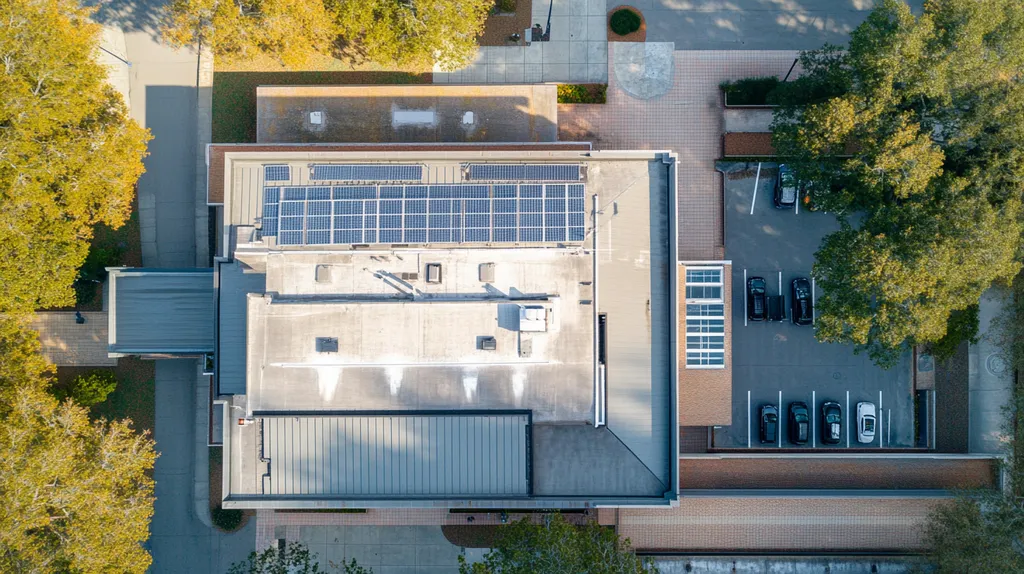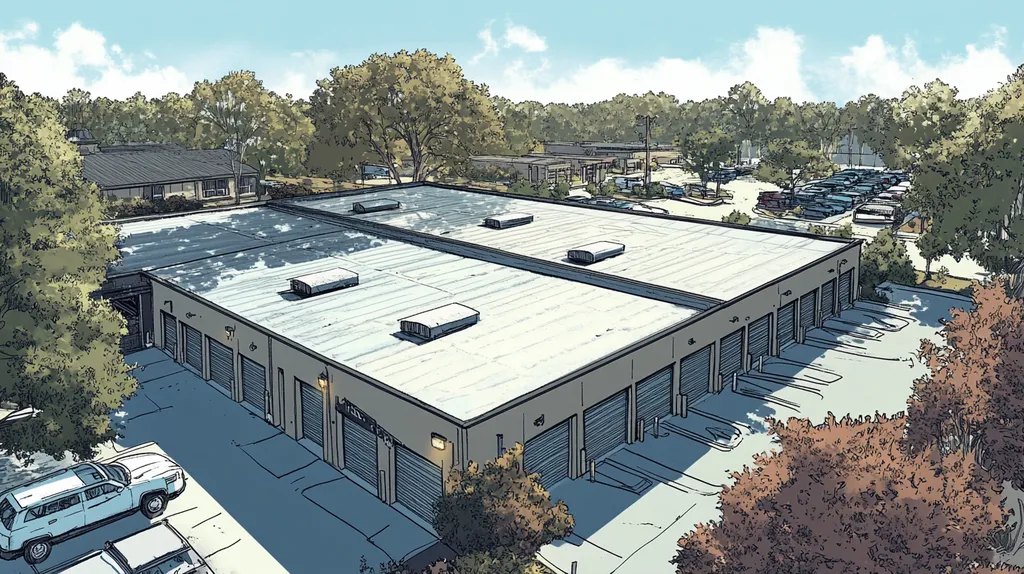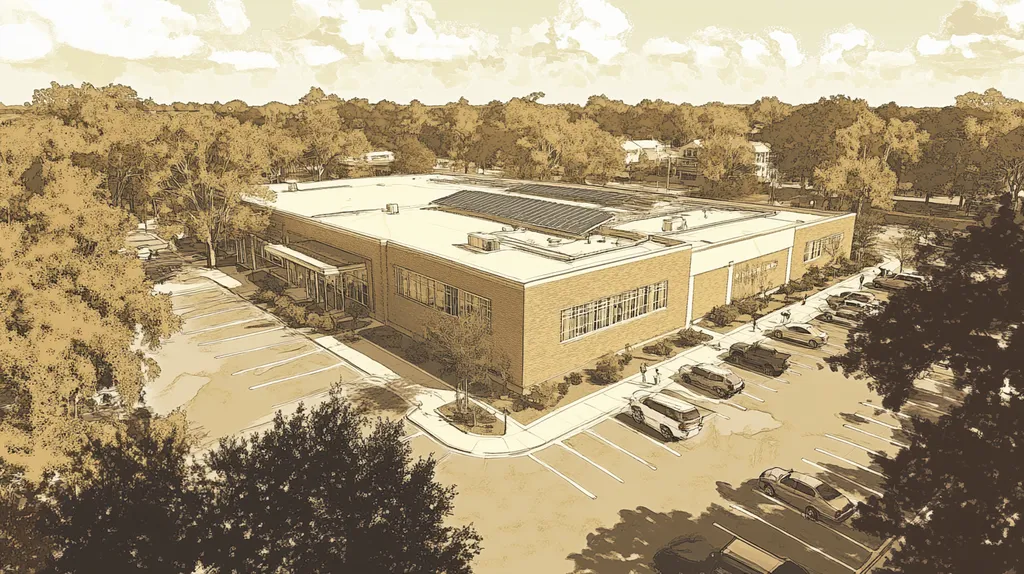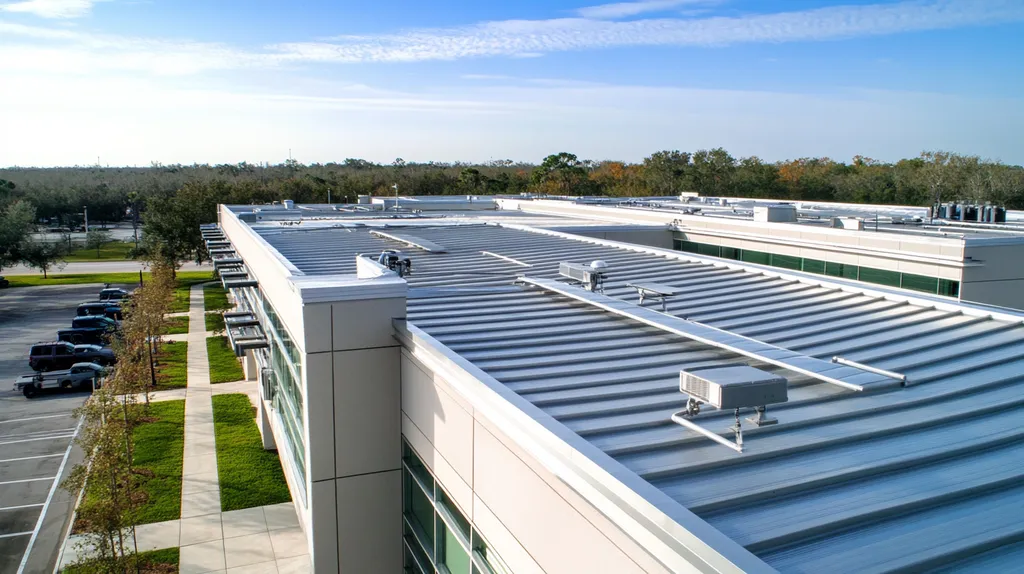Industrial roofing represents one of the most significant investments for commercial property owners, with costs ranging from $5 to $15 per square foot and potential long-term implications spanning decades.
Understanding the factors that influence total roofing costs is crucial, as making uninformed decisions can lead to expenses ballooning by up to 40% beyond initial estimates.
From material selection and climate considerations to maintenance requirements and energy efficiency, property owners must navigate numerous variables that impact both immediate and long-term costs.
This comprehensive guide examines the critical elements affecting industrial roofing expenses, providing facility managers and property owners with actionable insights for making cost-effective decisions.
SECTION 1: FUNDAMENTAL CONCEPTS
Understanding the total cost of industrial roofing is essential for property owners and facility managers. Making the wrong roofing choices can lead to severe financial consequences, including expensive repairs and operational setbacks. Key elements such as roof types, climate influences, and local regulations have a significant impact on these costs. This section delves into how each of these factors shapes the overall investment in industrial roofing.
Understanding Roof Types and Structures
The choice of roofing material plays a crucial role in determining total project costs. Common industrial roofing solutions include built-up roofs, single-ply membranes, and metal roofs. Each option presents varying lifespans, durability, and initial costs, all of which can shape a facility’s long-term budget.
For example, while single-ply membranes may come with lower upfront prices, they can incur higher maintenance costs over time due to susceptibility to punctures. On the other hand, metal roofs, although potentially pricier initially, often outlast other materials and require minimal maintenance, making them a wise long-term investment.
Additionally, the building structure itself can affect installation and maintenance expenses. Flat roofs, which are typical in many industrial settings, often demand special materials and skilled workmanship, raising the initial investment required.
Grasping these distinctions enables property owners to make informed decisions, balancing immediate budget concerns with their long-term operational objectives.
Impact of Climate and Weather
Climate and weather conditions are critical factors that influence roofing choices and associated costs. Areas that experience heavy snow, rain, or high temperatures need roofs capable of enduring these challenges. Overlooking local climate conditions can lead to premature roof failures.
Take, for instance, a facility situated in a hurricane-prone zone—it is prudent to invest in wind-rated materials. While this may entail higher upfront expenses, it drastically reduces insurance costs and minimizes potential storm damage, ultimately saving money on repairs and replacements over time.
Moreover, fluctuations in temperature can affect roofing materials, causing them to expand and contract and potentially leading to leaks. A keen understanding of local weather patterns is essential for selecting materials that will enhance the roof’s durability.
By considering climate conditions in their roofing decisions, property owners can steer clear of costly errors and establish a more resilient roofing system.
Local Building Codes and Regulations
Every region has specific building codes and regulations that govern roofing standards. Ignoring these regulations can lead to hefty fines, legal troubles, and expensive retrofits. Being aware of local codes is vital during the initial planning phase of any roofing project.
For example, certain areas mandate roofs to adhere to specific energy efficiency standards. Neglecting these regulations not only risks financial penalties but may also result in increased energy costs down the line.
Additionally, local codes often specify material requirements based on fire ratings or environmental considerations. Familiarity with these rules can save both time and money, ensuring compliance from the outset.
In summary, successfully navigating local building codes can profoundly impact the total cost of industrial roofing, influencing both decision-making and the overall success of the project.
SECTION 2: SYSTEM COMPONENTS
Grasping the various system components of industrial roofing is vital for keeping costs under control. Studies show that selecting the wrong materials can inflate expenses by as much as 40%. Therefore, property owners must make well-informed choices regarding roofing materials, labor costs, and the necessary insulation and underlayment. Each of these components significantly influences both the overall expenditure and the performance of the roofing system.
Roofing Material Options and Costs
The roofing material chosen has a direct impact on both the initial investment and future expenses. Common materials like TPO, EPDM, and metal each come with their own price and lifespan variations. For instance, TPO might cost between $3 and $7 per square foot, while metal roofs can range from $5 to $12 per square foot, depending on quality and specification.
Durability is another key factor that influences long-term costs. Metal roofs, although higher in upfront costs, often outlast TPO systems, resulting in lower repair and replacement expenses over time. Property owners should consider life-cycle costs as a more comprehensive measure of value instead of focusing solely on initial pricing.
Additionally, regional availability can affect material pricing. Areas with fewer suppliers may face higher costs, reinforcing the importance of sourcing materials locally whenever feasible. Understanding these factors empowers owners to make budget-friendly decisions that don’t compromise quality.
Ultimately, selecting the right materials is crucial for striking a balance between staying within budget and ensuring the roof’s longevity and performance.
Labor Costs and Contractor Expertise
Labor costs typically account for a significant portion of total roofing expenses. Skilled labor is vital to ensure the roofing system is correctly installed and adheres to industry standards. Although hiring experienced contractors might involve a higher initial cost, it protects against costly mistakes and repairs later on.
Different roofing systems can lead to varying labor costs. For example, a complex, multi-layered membrane system may require specialized skills and additional time compared to simpler asphalt-based systems, reflecting in overall labor rates. Conducting thorough vetting of contractors can lead to more reliable results and greater value.
The timing of the project can also impact labor costs. Roofing projects scheduled during peak seasons often come with higher pricing due to increased demand. Opting for off-peak periods can allow property owners to receive more competitive quotes and possible savings.
Choosing skilled labor not only enhances the quality of the roofing system but also leads to a better return on investment. The right expertise can make a significant difference in both the performance and longevity of the roof.
Underlayment and Insulation Requirements
Underlayment and insulation are integral components that significantly affect roofing performance. Proper underlayment acts as a barrier against moisture infiltration, while effective insulation improves energy efficiency. Overlooking these elements can result in higher energy costs or even structural issues down the line.
The type of insulation selected can impact overall costs significantly. Rigid foam insulation might typically cost between $1.50 and $3 per square foot, while spray foam insulation can fall between $2.50 and $5 per square foot. Understanding the specific climate needs can further enhance insulation effectiveness.
Moreover, installing these components often requires specialized labor, which can increase costs. In certain instances, choosing high-performance insulation may lead to rebates or incentives, helping to offset initial expenses.
Ultimately, neglecting these essential components can lead to expensive long-term problems. Proper insulation and underlayment should be viewed as necessary investments that uphold the overall integrity and efficiency of the roofing system.
SECTION 3: IMPLEMENTATION METHODS
When it comes to managing the costs of industrial roofing, understanding implementation methods is crucial. Property owners can incur significant unexpected expenses if they fail to consider certain factors. For instance, a roof with a complex design can lead to skyrocketing labor and material costs. This section covers essential factors such as roof size and complexity, access and logistics for installation, and the importance of safety features for compliance with regulations.
Roof Size and Complexity Considerations
The dimensions and intricacies of an industrial roof significantly impact overall costs. A larger roof naturally requires more materials and labor, raising expenses. Additionally, roofs with complex structures or multiple levels often complicate the installation process.
This added complexity can escalate inspection and engineering costs. Architects may need to invest in design changes to comply with local codes. Failing to consider these complexities upfront can lead to budget overruns, making it critical to plan ahead.
By consulting with roofing professionals early on, property owners can identify both expected and unforeseen challenges. Accurate assessments of roof layout and material choices can help mitigate costly surprises down the line.
In summary, being aware of the complexities associated with roof size can ultimately save property owners significant amounts of money. Thoughtful planning leads to a smoother installation process, supporting effective budget management.
Access and Logistics for Roof Installation
Roof accessibility is another vital factor that can greatly influence implementation costs. If a roof is challenging to reach, specialized equipment like cranes or scaffolding may be required, adding to project expenses. Urban locations often pose additional logistical hurdles due to space constraints.
These logistical challenges can also cause delays, resulting in higher costs. For example, if materials cannot be delivered due to access restrictions, timelines will extend, leading to increased expenses. Property owners must assess site conditions thoroughly to anticipate potential hurdles.
Maintaining open communication with contractors about access issues helps ensure that everyone is on the same page. This proactive approach can reduce the risk of costly delays and streamline the installation process.
Overall, incorporating accessibility and logistics considerations during the planning phase enhances operational efficiency and aids in cost management. Successful project execution hinges on properly evaluating these critical factors.
Safety Features and Compliance
Investing in safety measures and compliance is often seen as an extra cost, but it can lead to significant long-term savings. Adherence to safety regulations is essential; ignoring them can result in hefty fines. Moreover, prioritizing worker safety affects overall project costs and timelines.
Implementing features such as guardrails, safety harnesses, and reliable scaffolding not only promotes best practices but can also lower liability and insurance costs. When done right, safety measures increase job site efficiency and mitigate risks.
Neglecting these safety measures can lead to delays and financial penalties, both of which can dramatically raise total project costs. Therefore, prioritizing safety isn’t just a regulatory requirement; it’s a smart financial move.
By focusing on safety and compliance, property owners create a more resilient roofing system that can help cut long-term costs and reduce liability. A commitment to safety can safeguard financial resources and enhance the overall reputation of the company.
SECTION 4: MAINTENANCE REQUIREMENTS
Staying on top of industrial roofing maintenance is vital for avoiding hefty repair costs and maximizing the lifespan of the roof. Studies indicate that a well-maintained roof can last 50% longer than one that receives neglect. Property owners must recognize the crucial role of routine maintenance to safeguard their investments and prevent operational disruptions.
Routine Maintenance Tasks and Schedules
Routine maintenance is the backbone of roofing longevity. Regular inspections—preferably every six months—catch problems before they spiral out of control. Key tasks like removing debris, checking flashings, and inspecting seams should be included in a structured maintenance plan.
Moreover, cleaning gutters and drainage systems is essential for preventing water accumulation, which can lead to leaks and structural damage. Timing these tasks in advance ensures they don’t slip through the cracks. An active maintenance approach not only saves money but also enhances workplace safety.
Keeping detailed records of maintenance activities provides insight into the roof’s condition over time. This historical data can be invaluable for future inspections and decision-making about repairs or replacements. Consistent monitoring leads to smarter, more informed choices regarding roofing needs.
Partnering with a qualified roofing contractor for a maintenance service agreement can automate these schedules and offer expert oversight, ensuring all necessary tasks are performed on schedule and up to industry standards.
Repair and Replacement Strategies
Establishing a clear repair and replacement strategy is key to preserving roofing integrity. The first step is identifying the type of roofing material, as various materials require distinct approaches and timelines for effective repair.
Visible damage, like punctures or blisters, necessitates immediate attention. Delaying repairs can exacerbate the issue, leading to costlier consequences. Facilities managers should regularly assess their roofs to prioritize repairs based on urgency and prevalence.
When considering replacements, one should evaluate the roof’s age against the cost-effectiveness of repairs versus complete replacement. In some instances, investing in a full roof replacement may be more economical than repeatedly pouring money into repairs. Organizations should create a long-term budget that accommodates unanticipated repair expenditures.
Engaging in discussions with contractors about repair or replacement options fosters a personalized action plan tailored to varied roofing needs. Clear communication ensures that everyone involved comprehends the timelines and costs associated with each strategy.
Preventive Measures Against Common Issues
Implementing preventive measures is essential for sidestepping frequent roofing problems. Regular maintenance activities, such as sealing seams and applying protective coatings, can greatly reduce the risk of leaks. These proactive steps takedown potential issues before they can escalate into expensive repairs.
Proper ventilation is another crucial preventive measure. Ensuring adequate airflow beneath roofing materials helps minimize moisture buildup, a leading cause of roof deterioration. Facilities managers should routinely inspect ventilation systems to verify their efficiency.
Awareness of environmental impacts is equally important. Understanding how weather patterns affect roofing performance can help guide material selection and maintenance strategies. Proper installation and ongoing upkeep can mitigate numerous common issues.
Ultimately, investing in preventive measures results in a more effective roofing system that decreases long-term costs. This comprehensive preventive strategy ensures roofs not only last longer but operate at peak performance throughout their lifespan.
SECTION 5: PERFORMANCE METRICS
The stakes for optimizing industrial roofing costs are undeniably high. With the average industrial roof lifespan projected at around 20 years, property owners must scrutinize durability and performance metrics closely. Investing in a high-performance roof can lead to substantial savings in maintenance and energy consumption. Evaluating these metrics not only aids in making informed decisions but also influences long-term operational costs and the overall value of the property.
Evaluating Roof Durability and Lifespan
Durability and lifespan are pivotal metrics that directly impact roofing costs. A roof built to withstand harsh weather conditions can save businesses considerable money on repairs and replacements. For instance, a roof designed for over 30 years can prevent financially disruptive outages in business operations.
Materials like PVC and TPO are known for their durability, often surpassing traditional asphalt options. Choosing these high-performance materials can significantly reduce the frequency of required installations or major repairs, aligning with strategic long-term planning.
Furthermore, regular assessments play a crucial role in extending a roof’s lifespan. Property managers who schedule routine inspections can catch potential issues early, averting costly repairs later on. This proactive stance helps maintain the roof’s integrity, ensuring long-term savings.
In summary, selecting quality materials and adhering to a solid maintenance schedule directly influences long-term roofing costs. An informed approach to assessing durability and projected lifespan leads to smarter, cost-effective decisions for property owners.
Energy Efficiency and Cost Savings
Energy efficiency has become a vital performance metric in evaluating roofing systems, significantly impacting operational costs. Installing energy-efficient roofing materials can dramatically lower heating and cooling expenditures. For example, a reflective roof can curtail energy costs by as much as 30%, contingent on climate and insulation quality.
Incorporating high-quality insulation and reflective coatings can further boost energy conservation. Not only do these upgrades benefit the environment, but they also translate into tangible financial savings over time. Facilities that prioritize energy-efficient solutions typically observe faster returns on their roofing investments.
Additionally, many governments and utility companies provide incentives for energy-efficient upgrades. Property owners can leverage tax breaks or rebates, which help reduce the overall expenditure on new roofing solutions. Awareness of these opportunities can help optimize budget allocation.
Integrating energy efficiency into roofing decisions amplifies the financial advantages of well-crafted projects. This consideration is indispensable for any facility aiming to optimize its total roofing costs.
Compliance with Industry Standards
Compliance with industry standards is a critical aspect affecting roofing performance and costs. Regulations often dictate which materials and methods are permissible, thus impacting overall project expenses. Non-compliance can lead to fines and increase the risk of roof failure, which can lead to further financial strain.
Understanding local and national building codes is essential for making informed decisions. Ensuring that roofing systems meet these standards helps avoid legal complications and safety hazards. Additionally, adherence to industry guidelines can enhance the property’s value and marketability.
Particularly in industries such as pharmaceuticals and food services, stringent roofing requirements exist that protect against contamination and other hazards. Compliance with sector-specific standards enhances operational integrity and reduces liability.
Incorporating compliance into the overall roofing strategy is critical for long-term success. It safeguards investments while ensuring that roofing systems perform effectively throughout their operational lifespan.
SECTION 5: PERFORMANCE METRICS
The stakes for optimizing industrial roofing costs are substantial. With an average industrial roof lifespan estimated at around 20 years, property owners need to carefully assess durability and performance metrics. Investing in a high-performance roof can yield significant savings in both maintenance and energy consumption. By evaluating these metrics, property owners can make informed decisions that greatly influence long-term operational costs and overall property value.
Evaluating Roof Durability and Lifespan
Durability and lifespan are vitally important metrics that affect roofing costs. A roof engineered to withstand harsh weather conditions can save businesses considerable money on repairs and replacements. For example, a roof with a lifespan of over 30 years can help avoid financially disruptive outages and interruptions to business operations.
Materials like PVC and TPO are renowned for their durability, often outperforming traditional asphalt options. Opting for these high-performance materials can significantly decrease the frequency of required installations or major repairs. Therefore, selecting quality roofing materials from the start is crucial.
Additionally, conducting regular assessments plays an important role in extending a roof’s lifespan. Property managers who schedule routine inspections can identify potential issues early on, effectively preventing significant expenses down the road. This proactive stance is essential for maintaining the integrity of the roofing system.
Ultimately, investing in the right materials along with maintaining best practices directly impacts long-term roofing costs. A thorough evaluation of durability and projected lifespan can lead property owners to make smarter, more cost-effective roofing decisions.
Energy Efficiency and Cost Savings
Energy efficiency has reshaped how roofing performance is viewed, impacting operational costs dramatically. By using energy-efficient roofing materials, property owners can significantly cut down cooling and heating costs. For instance, a reflective roof can reduce energy expenses by up to 30%, depending on the climate and insulation quality.
Adding high-quality insulation and reflective coatings enhances energy conservation even further. These upgrades not only contribute positively to the environment, but they also translate into tangible financial savings over time. Facilities that emphasize energy-efficient solutions typically experience quicker returns on their roofing investments.
Moreover, many governments and utility companies provide incentives for energy-efficient upgrades. Property owners can take advantage of tax breaks or rebates, thereby reducing overall expenditures on new roofing solutions. Being aware of these incentives can significantly influence budget allocation.
Incorporating energy efficiency into roofing decisions maximizes the financial benefits of well-designed projects. This approach is essential for any facility striving to optimize its total roofing costs.
Compliance with Industry Standards
Compliance with industry standards is crucial for ensuring optimal roofing performance and controlling costs. Regulations often dictate the acceptable materials and methods used, which can directly impact overall project expenses. Failure to comply can lead to fines and increases the risk of roof failure, further escalating costs down the line.
A clear understanding of local and national building codes is essential for effective decision-making. By ensuring that roofing systems comply with these standards, property owners can avoid legal issues and safety hazards, while also enhancing property value and marketability.
In industries such as pharmaceuticals and food services, stringent roofing requirements exist to protect against contamination and other hazards. Meeting sector-specific standards not only preserves operational integrity but also reduces liability.
Integrating compliance into the overall roofing strategy is vital for long-term success. It safeguards investments while ensuring that roofing systems operate effectively throughout their lifespan.
The Bottom Line
With industrial roofing costs ranging from $5-15 per square foot and potential lifespans of 20-30 years, the financial implications of roofing decisions cannot be overstated.
Property owners who overlook critical factors like material selection, installation methods, and maintenance requirements risk seeing their expenses balloon by up to 40% beyond initial estimates.
Understanding and optimizing these various cost factors – from climate considerations to energy efficiency – can mean the difference between a roof that delivers decades of reliable service and one that becomes a constant drain on resources.
By taking a comprehensive approach that considers all cost-influencing elements, facility managers can make informed decisions that protect their investment while ensuring long-term operational efficiency.
The future of industrial roofing lies in this balanced approach to cost management, where initial expenses are weighed against long-term performance and sustainability goals.
FREQUENTLY ASKED QUESTIONS
Q. What factors influence the total cost of an industrial roof?
A. The cost is influenced by roof types, materials, building structure, and local regulations. Choosing the right roofing material can determine both initial and long-term costs, as some materials require more maintenance than others. Additionally, factors like climate or local building codes can significantly affect pricing and decisions.
Q. How do roofing materials affect the cost of a commercial roof?
A. Different materials come with varying costs and lifespans. For instance, while metal roofs might have higher upfront costs, they often last longer and require less maintenance compared to options like TPO, which might be cheaper initially but can incur higher long-term expenses. Understanding these differences is key to making budget-conscious decisions.
Q. What role does climate play in choosing an industrial roof?
A. Climate affects the durability and performance of roofing materials. For example, a facility in a snowy area needs a roof designed to handle heavy snow loads, which might increase initial costs but prevent future repairs. Ignoring climate factors can lead to premature roof failures and increased expenses.
Q. How can labor costs affect the pricing of a commercial roof?
A. Labor costs comprise a large portion of roofing expenses, influenced by contractor expertise and project complexity. A skilled contractor might charge more upfront but can prevent costly mistakes. Additionally, projects scheduled during peak seasons often incur higher labor rates, making timing a vital consideration for managing costs.
Q. Why is routine maintenance important for industrial roofs?
A. Routine maintenance is essential for extending a roof’s lifespan and mitigating hefty repair costs. Regular tasks like inspections, debris removal, and gutter cleaning can catch issues early, preventing more severe damage. A maintained roof can last significantly longer than one that is neglected, providing better value over time.
Q. What performance metrics should I evaluate for my industrial roof?
A. Key metrics include durability, lifespan, and energy efficiency. Evaluating these factors helps in understanding long-term costs and operational impacts. For instance, a durable roof reduces the frequency of repairs, while an energy-efficient roofing system can lead to substantial savings on utility bills.
Q. How can compliance with building codes impact industrial roofing costs?
A. Compliance with local building codes is crucial to avoid fines and ensure safety. Ignoring these regulations can lead to increased costs through legal penalties or the need for retrofits. By adhering to these standards, property owners can ensure their roofing projects are both safe and legally sound, preventing future financial burdens.









